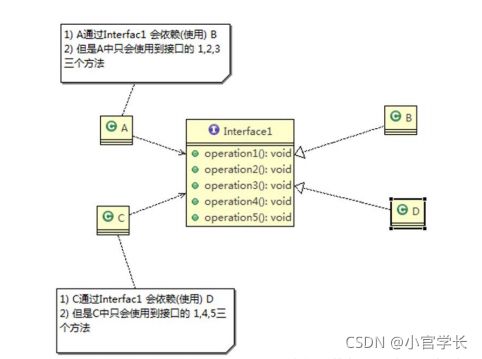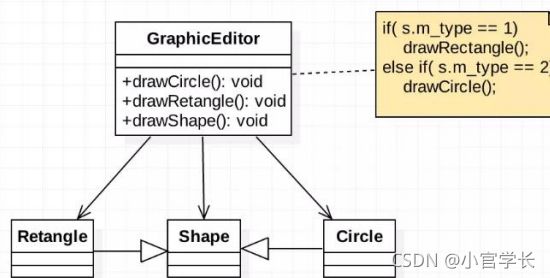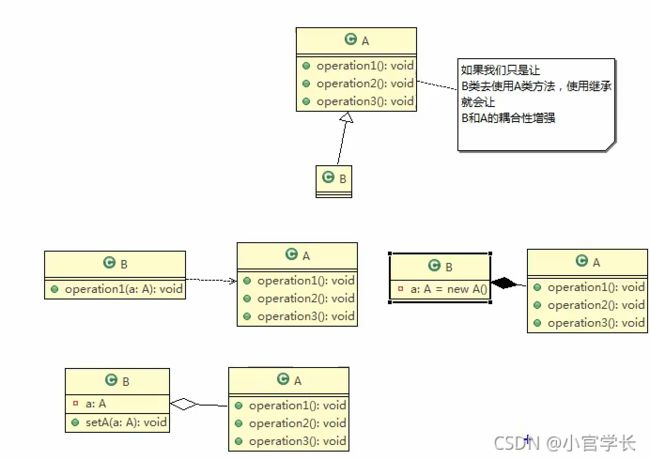设计模式七大原则(案例解析)
目录
一、 设计模式的目的
二. 设计模式七大原则
三、单一职责原则
3.1基本介绍
3.2应用实例:以交通工具案例讲解
3.3 单一职责原则注意事项和细节
四、 接口隔离原则(Interface Segregation Principle)
4.1 基本介绍
4.2 应用示例
4.3 传统方法的问题和使用接口隔离原则改进
五、 依赖倒转原则
5.1 基本介绍
5.2 应用实例
5.3 依赖关系传递的三种方式
5.4 依赖倒转原则的注意事项和细节
六、 里氏替换原则
6.1 OO中的继承性的思考和说明
6.2 基本介绍
七、开闭原则
7.1 基本介绍
八、 迪米特法则
8.1 基本介绍
8.2 应用实例
8.3 应用实例改进
8.4 迪米特法则注意事项和细节
九、合成复用原则(Composite Reuse Principle)
9.1 基本介绍
9.2 设计原则核心思想
一、 设计模式的目的
编写软件过程中,程序员面临着来自 耦合性,内聚性以及可维护性,可扩展性,重用性,灵活性 等多方面的挑战,设计模式是为了让程序(软件),具有更好
1) 代码重用性 (即:相同功能的代码,不用多次编写)
2) 可读性 (即:编程规范性, 便于其他程序员的阅读和理解)
3) 可扩展性 (即:当需要增加新的功能时,非常的方便,称为可维护)
4) 可靠性 (即:当我们增加新的功能后,对原来的功能没有影响)
5) 使程序呈现高内聚,低耦合的特性
二. 设计模式七大原则
设计模式原则,其实就是程序员在编程时,应当遵守的原则,也是各种设计模式的基础(即:设计模式为什么这样设计的依据)。
设计模式常用的七大原则有:
1) 单一职责原则
2) 接口隔离原则
3) 依赖倒转(倒置)原则
4) 里氏替换原则
5) 开闭原则
6) 迪米特法则
7) 合成复用原则
三、单一职责原则
3.1基本介绍
1、对类来说的,即一个类应该只负责一项职责。
2、如类A负责两个不 同职责:职责1,职责2。
3、当职责1需求变更而改变A时,可能造成职责2执行错误,所以 需要将类A的粒度分解为 A1,A2
3.2应用实例:以交通工具案例讲解
方案1:
package com.guan.principle.singleresponsibility;
public class SingleResponsibility1 {
public static void main(String[] args) {
// TODO Auto-generated method stub
Vehicle vehicle = new Vehicle();
vehicle.run("摩托车");
vehicle.run("汽车");
vehicle.run("飞机");
}
}
// 交通工具类
// 方式1
// 1. 在方式1 的run方法中,违反了单一职责原则
// 2. 解决的方案非常的简单,根据交通工具运行方法不同,分解成不同类即可
class Vehicle {
public void run(String vehicle) {
System.out.println(vehicle + " 在公路上运行....");
}
}//方案2
SingleResponsibility2.java
package com.guan.principle.singleresponsibility;
public class SingleResponsibility2 {
public static void main(String[] args) {
// TODO Auto-generated method stub
RoadVehicle roadVehicle = new RoadVehicle();
roadVehicle.run("摩托车");
roadVehicle.run("汽车");
AirVehicle airVehicle = new AirVehicle();
airVehicle.run("飞机");
}
}
//方案2的分析
//1. 遵守单一职责原则
//2. 但是这样做的改动很大,即将类分解,同时修改客户端
//3. 改进:直接修改Vehicle 类,改动的代码会比较少=>方案3
class RoadVehicle {
public void run(String vehicle) {
System.out.println(vehicle + "公路运行");
}
}
class AirVehicle {
public void run(String vehicle) {
System.out.println(vehicle + "天空运行");
}
}
class WaterVehicle {
public void run(String vehicle) {
System.out.println(vehicle + "水中运行");
}
}
方案3:
SingleResponsibility3.java
package com.guan.principle.singleresponsibility;
public class SingleResponsibility3 {
public static void main(String[] args) {
// TODO Auto-generated method stub
Vehicle2 vehicle2 = new Vehicle2();
vehicle2.run("汽车");
vehicle2.runWater("轮船");
vehicle2.runAir("飞机");
}
}
//方式3的分析
//1. 这种修改方法没有对原来的类做大的修改,只是增加方法
//2. 这里虽然没有在类这个级别上遵守单一职责原则,但是在方法级别上,仍然是遵守单一职责
class Vehicle2 {
public void run(String vehicle) {
//处理
System.out.println(vehicle + " 在公路上运行....");
}
public void runAir(String vehicle) {
System.out.println(vehicle + " 在天空上运行....");
}
public void runWater(String vehicle) {
System.out.println(vehicle + " 在水中行....");
}
}
3.3 单一职责原则注意事项和细节
1) 降低类的复杂度,一个类只负责一项职责。 2) 提高类的可读性,可维护性 3) 降低变更引起的风险 4) 通常情况下,我们应当遵守单一职责原则,只有逻辑足够简单,才可以在代码级别违反单一职责原则;只有类中方法数量足够少,可以在方法级别保持单一职责原则
四、 接口隔离原则(Interface Segregation Principle)
4.1 基本介绍
1) 客户端不应该依赖它不需要的接口,即一个类对另一个类的依赖,应该建立在最小的接口上
2) 先看一张图:
3) 类A通过接口Interface1依赖类B,类C通过接口Interface1依赖类D,如果接口Interface1对于类A和类C来说不是最小接口,那么类B和类D必须去实现他们不需要的方法。
4) 按隔离原则应当这样处理:
将接口Interface1拆分为独立的几个接口,类A和类C分别与他们需要的接口建立依赖关系。也就是采用接口隔离原则
4.2 应用示例
1) 类A通过接口Interface1依赖类B,类C通过接口Interface1依赖类D,请编写代码完成此应用实例。
没有使用接口隔离代码原则代码
package com.guan.principle.segregation;
public class Segregation1 {
public static void main(String[] args) {
// TODO Auto-generated method stub
}
}
//接口
interface Interface1 {
void operation1();
void operation2();
void operation3();
void operation4();
void operation5();
}
class B implements Interface1 {
public void operation1() {
System.out.println("B 实现了 operation1");
}
public void operation2() {
System.out.println("B 实现了 operation2");
}
public void operation3() {
System.out.println("B 实现了 operation3");
}
public void operation4() {
System.out.println("B 实现了 operation4");
}
public void operation5() {
System.out.println("B 实现了 operation5");
}
}
class D implements Interface1 {
public void operation1() {
System.out.println("D 实现了 operation1");
}
public void operation2() {
System.out.println("D 实现了 operation2");
}
public void operation3() {
System.out.println("D 实现了 operation3");
}
public void operation4() {
System.out.println("D 实现了 operation4");
}
public void operation5() {
System.out.println("D 实现了 operation5");
}
}
class A { //A 类通过接口Interface1 依赖(使用) B类,但是只会用到1,2,3方法
public void depend1(Interface1 i) {
i.operation1();
}
public void depend2(Interface1 i) {
i.operation2();
}
public void depend3(Interface1 i) {
i.operation3();
}
}
class C { //C 类通过接口Interface1 依赖(使用) D类,但是只会用到1,4,5方法
public void depend1(Interface1 i) {
i.operation1();
}
public void depend4(Interface1 i) {
i.operation4();
}
public void depend5(Interface1 i) {
i.operation5();
}
}
4.3 传统方法的问题和使用接口隔离原则改进
1) 类A通过接口Interface1依赖类B,类C通过接口Interface1依赖类D,如果接口Interface1对于类A和类C来说不是最小接口,那么类B和类D必须去实现他们不需要的方法
2) 将接口Interface1拆分为独立的几个接口,类A和类C分别与他们需要的接口建立依赖关系。也就是采用接口隔离原则
3) 接口Interface1中出现的方法,根据实际情况拆分为三个接口
4) 代码实现
package com.guan.principle.segregation.improve;
public class Segregation1 {
public static void main(String[] args) {
// TODO Auto-generated method stub
// 使用一把
A a = new A();
a.depend1(new B()); // A类通过接口去依赖B类
a.depend2(new B());
a.depend3(new B());
C c = new C();
c.depend1(new D()); // C类通过接口去依赖(使用)D类
c.depend4(new D());
c.depend5(new D());
}
}
// 接口1
interface Interface1 {
void operation1();
}
// 接口2
interface Interface2 {
void operation2();
void operation3();
}
// 接口3
interface Interface3 {
void operation4();
void operation5();
}
class B implements Interface1, Interface2 {
public void operation1() {
System.out.println("B 实现了 operation1");
}
public void operation2() {
System.out.println("B 实现了 operation2");
}
public void operation3() {
System.out.println("B 实现了 operation3");
}
}
class D implements Interface1, Interface3 {
public void operation1() {
System.out.println("D 实现了 operation1");
}
public void operation4() {
System.out.println("D 实现了 operation4");
}
public void operation5() {
System.out.println("D 实现了 operation5");
}
}
class A { // A 类通过接口Interface1,Interface2 依赖(使用) B类,但是只会用到1,2,3方法
public void depend1(Interface1 i) {
i.operation1();
}
public void depend2(Interface2 i) {
i.operation2();
}
public void depend3(Interface2 i) {
i.operation3();
}
}
class C { // C 类通过接口Interface1,Interface3 依赖(使用) D类,但是只会用到1,4,5方法
public void depend1(Interface1 i) {
i.operation1();
}
public void depend4(Interface3 i) {
i.operation4();
}
public void depend5(Interface3 i) {
i.operation5();
}
}
五、 依赖倒转原则
5.1 基本介绍
依赖倒转原则(Dependence Inversion Principle)是指:
1) 高层模块不应该依赖低层模块,二者都应该依赖其抽象
2) 抽象不应该依赖细节,细节应该依赖抽象
3) 依赖倒转(倒置)的中心思想是面向接口编程
4) 依赖倒转原则是基于这样的设计理念:相对于细节的多变性,抽象的东西要稳定的多。以抽象为基础搭建的架构比以细节为基础的架构要稳定的多。在java中,抽象指的是接口或抽象类,细节就是具体的实现类
5) 使用接口或抽象类的目的是制定好规范,而不涉及任何具体的操作,把展现细节的任务交给他们的实现类去完成
5.2 应用实例
请编程完成Person 接收消息 的功能
1) 实现方案1 + 分析说明
package com.guan.principle.inversion;
public class DependecyInversion {
public static void main(String[] args) {
Person person = new Person();
person.receive(new Email());
}
}
class Email {
public String getInfo() {
return "电子邮件信息: hello,world";
}
}
//完成Person接收消息的功能
//方式1分析
//1. 简单,比较容易想到
//2. 如果我们获取的对象是 微信,短信等等,则新增类,同时Perons也要增加相应的接收方法
//3. 解决思路:引入一个抽象的接口IReceiver, 表示接收者, 这样Person类与接口IReceiver发生依赖
// 因为Email, WeiXin 等等属于接收的范围,他们各自实现IReceiver 接口就ok, 这样我们就符号依赖倒转原则
class Person {
public void receive(Email email ) {
System.out.println(email.getInfo());
}
}
2) 实现方案2 + 分析说明
package com.guan.principle.inversion.improve;
public class DependecyInversion {
public static void main(String[] args) {
//客户端无需改变
Person person = new Person();
person.receive(new Email());
person.receive(new WeiXin());
}
}
//定义接口
interface IReceiver {
public String getInfo();
}
class Email implements IReceiver {
public String getInfo() {
return "电子邮件信息: hello,world";
}
}
//增加微信
class WeiXin implements IReceiver {
public String getInfo() {
return "微信信息: hello,ok";
}
}
//方式2
class Person {
//这里我们是对接口的依赖
public void receive(IReceiver receiver ) {
System.out.println(receiver.getInfo());
}
}
5.3 依赖关系传递的三种方式
1) 接口传递
2) 构造方法传递
3) setter方式传递
package com.guan.principle.inversion.improve;
public class DependencyPass {
public static void main(String[] args) {
// TODO Auto-generated method stub
ChangHong changHong = new ChangHong();
// OpenAndClose openAndClose = new OpenAndClose();
// openAndClose.open(changHong);
//通过构造器进行依赖传递
// OpenAndClose openAndClose = new OpenAndClose(changHong);
// openAndClose.open();
//通过setter方法进行依赖传递
OpenAndClose openAndClose = new OpenAndClose();
openAndClose.setTv(changHong);
openAndClose.open();
}
}
// 方式1: 通过接口传递实现依赖
// 开关的接口
// interface IOpenAndClose {
// public void open(ITV tv); //抽象方法,接收接口
// }
//
// interface ITV { //ITV接口
// public void play();
// }
//
// class ChangHong implements ITV {
//
// @Override
// public void play() {
// // TODO Auto-generated method stub
// System.out.println("长虹电视机,打开");
// }
//
// }
// 实现接口
// class OpenAndClose implements IOpenAndClose{
// public void open(ITV tv){
// tv.play();
// }
// }
// 方式2: 通过构造方法依赖传递
// interface IOpenAndClose {
// public void open(); //抽象方法
// }
// interface ITV { //ITV接口
// public void play();
// }
// class OpenAndClose implements IOpenAndClose{
// public ITV tv; //成员
// public OpenAndClose(ITV tv){ //构造器
// this.tv = tv;
// }
// public void open(){
// this.tv.play();
// }
// }
// 方式3 , 通过setter方法传递
interface IOpenAndClose {
public void open(); // 抽象方法
public void setTv(ITV tv);
}
interface ITV { // ITV接口
public void play();
}
class OpenAndClose implements IOpenAndClose {
private ITV tv;
public void setTv(ITV tv) {
this.tv = tv;
}
public void open() {
this.tv.play();
}
}
class ChangHong implements ITV {
@Override
public void play() {
// TODO Auto-generated method stub
System.out.println("长虹电视机,打开");
}
}
5.4 依赖倒转原则的注意事项和细节
1) 低层模块尽量都要有抽象类或接口,或者两者都有,程序稳定性更好
2) 变量的声明类型尽量是抽象类或接口, 这样我们的变量引用和实际对象间,就存在一个缓冲层,利于程序扩展和优化
3) 继承时遵循里氏替换原则
六、 里氏替换原则
6.1 OO中的继承性的思考和说明
1) 继承包含这样一层含义:父类中凡是已经实现好的方法,实际上是在设定规范和契约,虽然它不强制要求所有的子类必须遵循这些契约,但是如果子类对这些已经实现的方法任意修改,就会对整个继承体系造成破坏。
2) 继承在给程序设计带来便利的同时,也带来了弊端。比如使用继承会给程序带来侵入性,程序的可移植性降低,增加对象间的耦合性,如果一个类被其他的类所继承,则当这个类需要修改时,必须考虑到所有的子类,并且父类修改后,所有涉及到子类的功能都有可能产生故障
3) 问题提出:在编程中,如何正确的使用继承? => 里氏替换原则
6.2 基本介绍
1) 里氏替换原则(Liskov Substitution Principle)在1988年,由麻省理工学院的以为姓里的女士提出的。
2) 如果对每个类型为T1的对象o1,都有类型为T2的对象o2,使得以T1定义的所有程序P在所有的对象o1都代换成o2时,程序P的行为没有发生变化,那么类型T2是类型T1的子类型。换句话说,所有引用基类的地方必须能透明地使用其子类的对象。
3) 在使用继承时,遵循里氏替换原则,在子类中尽量不要重写父类的方法
4) 里氏替换原则告诉我们,继承实际上让两个类耦合性增强了,在适当的情况下,可以通过聚合,组合,依赖 来解决问题。.
一个程序引出的问题和思考
package com.guan.principle.liskov;
public class Liskov {
public static void main(String[] args) {
// TODO Auto-generated method stub
A a = new A();
System.out.println("11-3=" + a.func1(11, 3));
System.out.println("1-8=" + a.func1(1, 8));
System.out.println("-----------------------");
B b = new B();
System.out.println("11-3=" + b.func1(11, 3));//这里本意是求出11-3
System.out.println("1-8=" + b.func1(1, 8));// 1-8
System.out.println("11+3+9=" + b.func2(11, 3));
}
}
// A类
class A {
// 返回两个数的差
public int func1(int num1, int num2) {
return num1 - num2;
}
}
// B类继承了A
// 增加了一个新功能:完成两个数相加,然后和9求和
class B extends A {
//这里,重写了A类的方法, 可能是无意识
public int func1(int a, int b) {
return a + b;
}
public int func2(int a, int b) {
return func1(a, b) + 9;
}
}
解决方法:
1) 我们发现原来运行正常的相减功能发生了错误。原因就是类B无意中重写了父类的方法,造成原有功能出现错误。在实际编程中,我们常常会通过重写父类的方法完成新的功能,这样写起来虽然简单,但整个继承体系的复用性会比较差。特别是运行多态比较频繁的时候
2) 通用的做法是:原来的父类和子类都继承一个更通俗的基类,原有的继承关系去掉,采用依赖,聚合,组合等关系代替.
package com.guan.principle.liskov.improve;
public class Liskov {
public static void main(String[] args) {
// TODO Auto-generated method stub
A a = new A();
System.out.println("11-3=" + a.func1(11, 3));
System.out.println("1-8=" + a.func1(1, 8));
System.out.println("-----------------------");
B b = new B();
//因为B类不再继承A类,因此调用者,不会再func1是求减法
//调用完成的功能就会很明确
System.out.println("11+3=" + b.func1(11, 3));//这里本意是求出11+3
System.out.println("1+8=" + b.func1(1, 8));// 1+8
System.out.println("11+3+9=" + b.func2(11, 3));
//使用组合仍然可以使用到A类相关方法
System.out.println("11-3=" + b.func3(11, 3));// 这里本意是求出11-3
}
}
//创建一个更加基础的基类
class Base {
//把更加基础的方法和成员写到Base类
}
// A类
class A extends Base {
// 返回两个数的差
public int func1(int num1, int num2) {
return num1 - num2;
}
}
// B类继承了A
// 增加了一个新功能:完成两个数相加,然后和9求和
class B extends Base {
//如果B需要使用A类的方法,使用组合关系
private A a = new A();
//这里,重写了A类的方法, 可能是无意识
public int func1(int a, int b) {
return a + b;
}
public int func2(int a, int b) {
return func1(a, b) + 9;
}
//我们仍然想使用A的方法
public int func3(int a, int b) {
return this.a.func1(a, b);
}
}
七、开闭原则
7.1 基本介绍
1) 开闭原则(Open Closed Principle)是编程中最基础、最重要的设计原则
2) 一个软件实体如类,模块和函数应该对扩展开放(对提供方),对修改关闭(对使用方)。用抽象构建框架,用实现扩展细节。
3) 当软件需要变化时,尽量通过扩展软件实体的行为来实现变化,而不是通过修改已有的代码来实现变化。
4) 编程中遵循其它原则,以及使用设计模式的目的就是遵循开闭原则。
方式1的优缺点
1) 优点是比较好理解,简单易操作。
2) 缺点是违反了设计模式的ocp原则,即对扩展开放(提供方),对修改关闭(使用方)。即当我们给类增加新功能的时候,尽量不修改代码,或者尽可能少修改代码.
3) 比如我们这时要新增加一个图形种类 三角形,我们需要做如下修改,修改的地方较多
4) 代码演示
package com.guan.principle.ocp;
public class Ocp {
public static void main(String[] args) {
//使用看看存在的问题
GraphicEditor graphicEditor = new GraphicEditor();
graphicEditor.drawShape(new Rectangle());
graphicEditor.drawShape(new Circle());
graphicEditor.drawShape(new Triangle());
}
}
//这是一个用于绘图的类 [使用方]
class GraphicEditor {
//接收Shape对象,然后根据type,来绘制不同的图形
public void drawShape(Shape s) {
if (s.m_type == 1)
drawRectangle(s);
else if (s.m_type == 2)
drawCircle(s);
else if (s.m_type == 3)
drawTriangle(s);
}
//绘制矩形
public void drawRectangle(Shape r) {
System.out.println(" 绘制矩形 ");
}
//绘制圆形
public void drawCircle(Shape r) {
System.out.println(" 绘制圆形 ");
}
//绘制三角形
public void drawTriangle(Shape r) {
System.out.println(" 绘制三角形 ");
}
}
//Shape类,基类
class Shape {
int m_type;
}
class Rectangle extends Shape {
Rectangle() {
super.m_type = 1;
}
}
class Circle extends Shape {
Circle() {
super.m_type = 2;
}
}
//新增画三角形
class Triangle extends Shape {
Triangle() {
super.m_type = 3;
}
}
方式二
改进的思路分析
思路:把创建Shape类做成抽象类,并提供一个抽象的draw方法,让子类去实现即可,这样我们有新的图形种类时,只需要让新的图形类继承Shape,并实现draw方法即可,
使用方的代码就不需要修 -> 满足了开闭原则
package com.guan.principle.ocp.improve;
public class Ocp {
public static void main(String[] args) {
//使用看看存在的问题
GraphicEditor graphicEditor = new GraphicEditor();
graphicEditor.drawShape(new Rectangle());
graphicEditor.drawShape(new Circle());
graphicEditor.drawShape(new Triangle());
graphicEditor.drawShape(new OtherGraphic());
}
}
//这是一个用于绘图的类 [使用方]
class GraphicEditor {
//接收Shape对象,调用draw方法
public void drawShape(Shape s) {
s.draw();
}
}
//Shape类,基类
abstract class Shape {
int m_type;
public abstract void draw();//抽象方法
}
class Rectangle extends Shape {
Rectangle() {
super.m_type = 1;
}
@Override
public void draw() {
// TODO Auto-generated method stub
System.out.println(" 绘制矩形 ");
}
}
class Circle extends Shape {
Circle() {
super.m_type = 2;
}
@Override
public void draw() {
// TODO Auto-generated method stub
System.out.println(" 绘制圆形 ");
}
}
//新增画三角形
class Triangle extends Shape {
Triangle() {
super.m_type = 3;
}
@Override
public void draw() {
// TODO Auto-generated method stub
System.out.println(" 绘制三角形 ");
}
}
//新增一个图形
class OtherGraphic extends Shape {
OtherGraphic() {
super.m_type = 4;
}
@Override
public void draw() {
// TODO Auto-generated method stub
System.out.println(" 绘制其它图形 ");
}
}
八、 迪米特法则
8.1 基本介绍
1) 一个对象应该对其他对象保持最少的了解
2) 类与类关系越密切,耦合度越大
3) 迪米特法则(Demeter Principle)又叫最少知道原则,即一个类对自己依赖的类知道的
越少越好。也就是说,对于被依赖的类不管多么复杂,都尽量将逻辑封装在类的内
部。对外除了提供的public 方法,不对外泄露任何信息
4) 迪米特法则还有个更简单的定义:只与直接的朋友通信
5) 直接的朋友:每个对象都会与其他对象有耦合关系,只要两个对象之间有耦合关系,我们就说这两个对象之间是朋友关系。耦合的方式很多,依赖,关联,组合,聚合等。其中,我们称出现成员变量,方法参数,方法返回值中的类为直接的朋友,而出现在局部变量中的类不是直接的朋友。也就是说,陌生的类最好不要以局部变量的形式出现在类的内部。
8.2 应用实例
1) 有一个学校,下属有各个学院和总部,现要求打印出学校总部员工ID和学院员工的id
package com.guan.principle.demeter;
import java.util.ArrayList;
import java.util.List;
//客户端
public class Demeter1 {
public static void main(String[] args) {
//创建了一个 SchoolManager 对象
SchoolManager schoolManager = new SchoolManager();
//输出学院的员工id 和 学校总部的员工信息
schoolManager.printAllEmployee(new CollegeManager());
}
}
//学校总部员工类
class Employee {
private String id;
public void setId(String id) {
this.id = id;
}
public String getId() {
return id;
}
}
//学院的员工类
class CollegeEmployee {
private String id;
public void setId(String id) {
this.id = id;
}
public String getId() {
return id;
}
}
//管理学院员工的管理类
class CollegeManager {
//返回学院的所有员工
public List getAllEmployee() {
List list = new ArrayList();
for (int i = 0; i < 10; i++) { //这里我们增加了10个员工到 list
CollegeEmployee emp = new CollegeEmployee();
emp.setId("学院员工id= " + i);
list.add(emp);
}
return list;
}
}
//学校管理类
//分析 SchoolManager 类的直接朋友类有哪些 Employee、CollegeManager
//CollegeEmployee 不是 直接朋友 而是一个陌生类,这样违背了 迪米特法则
class SchoolManager {
//返回学校总部的员工
public List getAllEmployee() {
List list = new ArrayList();
for (int i = 0; i < 5; i++) { //这里我们增加了5个员工到 list
Employee emp = new Employee();
emp.setId("学校总部员工id= " + i);
list.add(emp);
}
return list;
}
//该方法完成输出学校总部和学院员工信息(id)
void printAllEmployee(CollegeManager sub) {
//分析问题
//1. 这里的 CollegeEmployee 不是 SchoolManager的直接朋友
//2. CollegeEmployee 是以局部变量方式出现在 SchoolManager
//3. 违反了 迪米特法则
//获取到学院员工
List list1 = sub.getAllEmployee();
System.out.println("------------学院员工------------");
for (CollegeEmployee e : list1) {
System.out.println(e.getId());
}
//获取到学校总部员工
List list2 = this.getAllEmployee();
System.out.println("------------学校总部员工------------");
for (Employee e : list2) {
System.out.println(e.getId());
}
}
}
8.3 应用实例改进
package com.guan.principle.demeter.improve;
import java.util.ArrayList;
import java.util.List;
//客户端
public class Demeter1 {
public static void main(String[] args) {
System.out.println("~~~使用迪米特法则的改进~~~");
//创建了一个 SchoolManager 对象
SchoolManager schoolManager = new SchoolManager();
//输出学院的员工id 和 学校总部的员工信息
schoolManager.printAllEmployee(new CollegeManager());
}
}
//学校总部员工类
class Employee {
private String id;
public void setId(String id) {
this.id = id;
}
public String getId() {
return id;
}
}
//学院的员工类
class CollegeEmployee {
private String id;
public void setId(String id) {
this.id = id;
}
public String getId() {
return id;
}
}
//管理学院员工的管理类
class CollegeManager {
//返回学院的所有员工
public List getAllEmployee() {
List list = new ArrayList();
for (int i = 0; i < 10; i++) { //这里我们增加了10个员工到 list
CollegeEmployee emp = new CollegeEmployee();
emp.setId("学院员工id= " + i);
list.add(emp);
}
return list;
}
//输出学院员工的信息
public void printEmployee() {
//获取到学院员工
List list1 = getAllEmployee();
System.out.println("------------学院员工------------");
for (CollegeEmployee e : list1) {
System.out.println(e.getId());
}
}
}
//学校管理类
//分析 SchoolManager 类的直接朋友类有哪些 Employee、CollegeManager
//CollegeEmployee 不是 直接朋友 而是一个陌生类,这样违背了 迪米特法则
class SchoolManager {
//返回学校总部的员工
public List getAllEmployee() {
List list = new ArrayList();
for (int i = 0; i < 5; i++) { //这里我们增加了5个员工到 list
Employee emp = new Employee();
emp.setId("学校总部员工id= " + i);
list.add(emp);
}
return list;
}
//该方法完成输出学校总部和学院员工信息(id)
void printAllEmployee(CollegeManager sub) {
//分析问题
//1. 将输出学院的员工方法,封装到CollegeManager
sub.printEmployee();
//获取到学校总部员工
List list2 = this.getAllEmployee();
System.out.println("------------学校总部员工------------");
for (Employee e : list2) {
System.out.println(e.getId());
}
}
}
8.4 迪米特法则注意事项和细节
1) 迪米特法则的核心是降低类之间的耦合
2) 但是注意:由于每个类都减少了不必要的依赖,因此迪米特法则只是要求降低类间(对象间)耦合关系, 并不是要求完全没有依赖关系
九、合成复用原则(Composite Reuse Principle)
9.1 基本介绍
合成复用原则是尽量使用合成/聚合的方式,而不是使用继承
9.2 设计原则核心思想
1) 找出应用中可能需要变化之处,把它们独立出来,不要和那些不需要变化的代码混在一起。
2) 针对接口编程,而不是针对实现编程。
3) 为了交互对象之间的松耦合设计而努力。




